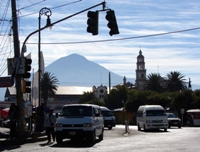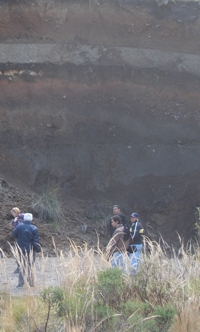With support from the Cabot Institute Volcanoes and Society Small Awards, I visited the Popocatapétl area in December 2012 with colleagues from Universidad Nacional Autónoma de México, University of Cambridge, Macquarie University, Institut de Physique du Globe de Paris and Istituto Nazionale di Geofisica e Vulcanologia. Part of our plan had been to investigate the physical and social impacts of recurrent ash falls and the threat of evacuation on local communities; however the ongoing volcanic activity and potential for an eruption with little warning meant that we were not able to enter the areas impacted or under threat (exclusion zones). We therefore took the opportunity to study previous eruption deposits and to learn more about the hazard posed by Popocatapétl from scientists studying the volcano.
The last Plinian eruption of Popocatapétl 1100 years ago left a deep (>300 m) crater at the summit. Subsequent smaller eruptions have involved the emplacement and partial destruction of lava domes within this crater and as a result, the crater is now nearly filled with lava dome material. This means that in future eruptions pyroclastic density currents (some of the most complex, destructive and least predictable volcanic processes) may no longer be confined by the crater walls. With more than 10 million people now living within 70 km of the summit, there is justifiable concern about the potentially devastating consequences of a future major eruption at Popocatapétl.
We studied the deposit characteristics of three major Plinian eruptions: approximately 2,150 years, 5,000 years and 17,000 years ago. The pattern of eruptive activity at Popocatapétl is still poorly understood but the Plinian eruptions we studied exhibit a similar sequence of deposits, with dilute and mobile pyroclastic density currents (surges) at the base, followed by extensive pumice fallout and finally the emplacement of concentrated pyroclastic density currents, sometimes associated with partial caldera collapse.
Archaeological remains of settlements destroyed during the more recent Plinian eruptions have been found within pyroclastic density current and lahar (mudflow) deposits around the volcano. Pumice deposits of more than 10 cm have been found in what is now the megacity of Mexico City, deposited during a Plinian eruption of Popocatapétl 17,000 years ago. Similar eruptions occurring today would cause major disruption to transport, business, critical infrastructure and food supply, and would require extensive clean-up. Ongoing assessment of the potential hazards and risks associated with an eruption of Popocatapétl, as well as of the magnitude and spatial extent of likely consequences, are helping to inform planning for a future crisis.
My sincere thanks are due to scientists from the Universidad Nacional Autónoma de México for sharing their expertise and supporting our field studies and to the Cabot Institute for making the visit possible.
Report and photographs by Dr Susanna Jenkins
Relevant Popocatapétl reading
Arana-Salinas, L., Siebe, C. and Macías, J.L., 2010. Dynamics of the ca. 4965 yr 14C BP “Ochre Pumice” Plinian eruption of Popocatépetl volcano, México. Journal of Volcanology and Geothermal Research, 192: 212-231.
Macıas, J.L. and Siebe, C., 2005. Popocatepetl’s crater filled to the brim: significance for hazard evaluation. Journal of Volcanology and Geothermal Research, 141: 327-330.
Sosa-Ceballos, G., Gardner, J.E., Siebe, C. and Macias, J.L., 2012. A caldera-forming eruption ~14,100 14C yr BP at Popocatépetl volcano, México: Insights from eruption dynamics and magma mixing. Journal of Volcanology and Geothermal Research, 231-214: 27-40.


